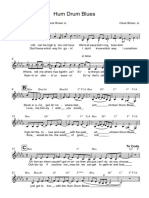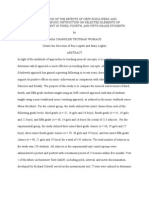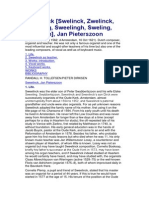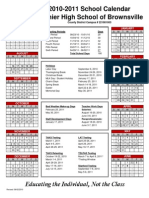0 ratings0% found this document useful (0 votes)
197 viewsA Comparison of Music Education Philosophy Nicole Hunt
A Comparison of Music Education Philosophy Nicole Hunt
Uploaded by
NikMezzoThis document compares the philosophies of Bennett Reimer and David Elliott regarding music education. Reimer's "music education as aesthetic education" philosophy focuses on developing aesthetic perception through observing musical works. Elliott's "praxial" philosophy centers on the action of music making and defines music as a process based on context. While differing in their views of music and curriculum, the philosophies both acknowledge music's cognitive nature and importance of musical qualities. Elements of both could provide benefits in the music classroom.
Copyright:
© All Rights Reserved
Available Formats
Download as DOCX, PDF, TXT or read online from Scribd
A Comparison of Music Education Philosophy Nicole Hunt
A Comparison of Music Education Philosophy Nicole Hunt
Uploaded by
NikMezzo0 ratings0% found this document useful (0 votes)
197 views7 pagesThis document compares the philosophies of Bennett Reimer and David Elliott regarding music education. Reimer's "music education as aesthetic education" philosophy focuses on developing aesthetic perception through observing musical works. Elliott's "praxial" philosophy centers on the action of music making and defines music as a process based on context. While differing in their views of music and curriculum, the philosophies both acknowledge music's cognitive nature and importance of musical qualities. Elements of both could provide benefits in the music classroom.
Original Description:
A comparison of the major music education philosophies currently used in American programs.
Copyright
© © All Rights Reserved
Available Formats
DOCX, PDF, TXT or read online from Scribd
Share this document
Did you find this document useful?
Is this content inappropriate?
This document compares the philosophies of Bennett Reimer and David Elliott regarding music education. Reimer's "music education as aesthetic education" philosophy focuses on developing aesthetic perception through observing musical works. Elliott's "praxial" philosophy centers on the action of music making and defines music as a process based on context. While differing in their views of music and curriculum, the philosophies both acknowledge music's cognitive nature and importance of musical qualities. Elements of both could provide benefits in the music classroom.
Copyright:
© All Rights Reserved
Available Formats
Download as DOCX, PDF, TXT or read online from Scribd
Download as docx, pdf, or txt
0 ratings0% found this document useful (0 votes)
197 views7 pagesA Comparison of Music Education Philosophy Nicole Hunt
A Comparison of Music Education Philosophy Nicole Hunt
Uploaded by
NikMezzoThis document compares the philosophies of Bennett Reimer and David Elliott regarding music education. Reimer's "music education as aesthetic education" philosophy focuses on developing aesthetic perception through observing musical works. Elliott's "praxial" philosophy centers on the action of music making and defines music as a process based on context. While differing in their views of music and curriculum, the philosophies both acknowledge music's cognitive nature and importance of musical qualities. Elements of both could provide benefits in the music classroom.
Copyright:
© All Rights Reserved
Available Formats
Download as DOCX, PDF, TXT or read online from Scribd
Download as docx, pdf, or txt
You are on page 1of 7
A Comparison of Music Education Philosophy 1
A Comparison of Music Education Philosophy
Nicole Hunt
Stephen F. Austin State University
A Comparison of Music Education Philosophy 2
The study of music education philosophy in North America has been primarily divided
into two major tenets, the aesthetic philosophy of Bennett Reimer, as outlined in his book, A
Philosophy of Music Education(1970,1989,2003), and the praxial philosophy of David J. Elliott,
as outlined in his book, Music Matters(1995). As one of the oldest educational philosophies in
music, Reimers music education as aesthetic education or MEAE has until recent years
been the primary philosophy used by practitioners (Elliott, 1995, p. 28). Elliotts text presents
itself as a fundamentally opposite axiom that has been embraced by some contemporary
educators (p.14). Seemingly different in their ideologies, Elliott and Reimer contrast on the
views of what music is, the place and value of musical education, and the curriculum of an ideal
music education practice. This paper will seek to identify and explain the educational ideologies
of both philosophies and discover what possible practical applications in the music classroom
may be gleaned from each.
The study of aesthetics in general concerns itself with the perception and nature of the
senses, which eventually developed into a term that loosely defines itself as the study of beauty
and the arts (Elliott, 1995, p. 22). A concept arising from the eighteenth and nineteenth
centuries, aesthetic education has a varied and continually evolving philosophy that has been
used extensively in the western world (p.22). While Bennett Reimer is not the first philosopher
to synthesize music education and aesthetics, Reimer was the first fully realized music
education philosophy to become effective on a grand scale (p. 28). Bennett Reimer has
reformulated his philosophy twice since its inception in 1970. Bennett has since provided a more
praxial approach to aesthetic education in the 2003 edition of his book (Maattanen, 2003).
However, for the basis of this comparison, his 1970 and 1989 edition texts will be referenced.
Reimer provides a definition of music as a type of cognition (Reimer, 1989,p. 11) , that is
separated from other forms of cognition by its intrinsic value and expressive qualities. In
accordance to this, Reimer deems the value of music to be its ability to aid the process of
A Comparison of Music Education Philosophy 3
human feeling that is specific to music alone(p.85). This definition of music greatly informs his
educational philosophy, which is chiefly based on the aesthetic philosophies of John Dewey and
Susanne Langer (Reimer, 1970, p. 102). Both ideologies regard participation in music as an
aesthetic experience (p. 102).
Reimer defines an aesthetic experience as the interaction between the perception and
reaction of the expressive qualities than an object embodies, which in his philosophy would be a
musical work (Reimer, 1970,p. 107). Reimer believes that the basis of music education should
be built around this concept of aesthetic experience (p. 109). Thus, MEAE philosophy involves
the development of aesthetic perception through specific musical works, rather than
performance based musical learning (p.108). Musical works are objects to be observed, and
elements such as melody, timbre, rhythm, and harmony are seen as aesthetic qualities that aid
in the observation and aesthetic understanding of musical works (p.108). Through the process
of aesthetic perception, aesthetic sensitivity is attained, which is deemed essential to aesthetic
experience (p.109). Reimer encourages the instruction of musical perception by trained
practitioners, or musical experts, using music that is deemed as good or expressive, the
most noted of which to Reimer is Western Art Music(Reimer, 1989,p. 97).
Therefore, an aesthetic educational experience in music involves an autonomous
musical object, which is to be perceived aesthetically using aesthetic qualities, and will have a
reactionary result of an aesthetic experience (Reimer,1970,p.109). In the classroom, in my
opinion, this will usually be linked to listening and theoretical concerns. Music theory analyses
the structural elements or aesthetic elements of a musical work so that they may be
understood. Another example is the study of music history uses listening to historical works to
understand the various musical elements that lend themselves to a particular time period. This
is seemingly the method used by the majority of American classrooms until Elliots philosophy
became available.
A Comparison of Music Education Philosophy 4
Elliott positions his educational philosophy as the opposite of Reimer (Elliott, 1995, p.
14). Whereas Reimer is concerned with the aesthetic experience which involves distanced
perception, Elliotts philosophy centers on the action of music making (p. 22). In turn, Elliott calls
this philosophy praxial as it concerns itself with the action of music making in specific
contextual practices ( p. 14). Elliott defines music as a distinctly human process, cognitive in
nature which is diverse and multi-dimensional and based on context (p. 52). Elliott derives
music value from the experience of music making that he believes leads to the human values of
self-knowledge, self-growth, and optimal experience (p. 128). Elliott characterizes musical
experiences by the involvement in musical action, which he refers to as musicing, and listening
(p. 129). These experiences are qualified by musicianship and music challenges and are
cultural and multifaceted in nature (p. 129). Musical works are not necessarily objects in his
philosophy but products of the action of music making in a situated cultural context that can
contain multiple dimensions (p. 129).
Elliott suggests a curriculum that encourages musical development through
knowledgeable action (Elliott, 1995, p. 242). This is built through Elliotts concepts of
musicianship and several other types of musical knowledge and ways of knowing. Elliott
proposes a pedagogy that employs reflective practitioners steeped in musical practice and their
apprentice practitioners, or students, and the process of music making (p. 260). Elliott believes
that the process of performance informs other aspects of the musical experience including
listening, composing, and conducting (p. 33). The author also encourages the teaching of
musicianship, on which he has placed a specialized focus (p. 53). Praxial philosophy also
calls for a multicultural education, utilizing music from a variety of contexts, deemed appropriate
by the practitioner in practice (p. 207). No one practice or type of music is the correct type of
music for education. Praxial philosophy sees music education as a musical experience derived
from musical actions in specific contexts (p. 129).
A Comparison of Music Education Philosophy 5
In the music classroom, this can have several practical applications. For instance, the
voice teacher that models for and performs with his or her student would exemplify this music in
action relationship. The relationship could also be seen in the general music class that employs
the use of guided instrument play and contextual observation. As a participant in the music
making process with the students the practitioner serves as a model of musicianship in multiple
facets for the students. The students may also be involved in the observation of a diverse set of
musicians performing music based upon their own cultural contexts; this would also seem to fit
in with a curriculum based upon praxial philosophy.
While the philosophical differences are prominent between these two factions of music
education, there are also similarities between the two. Both philosophies acknowledge the
cognitive nature of music and that its inherent value is based upon its unique interactions with
human beings (Reimer, 1989, p.11) (Elliott,1995, p.52 ). Also, both philosophies seem to focus
on musical qualities that they place in a position of importance (Elliott,1995, p. 84). Whether
these qualities are deemed artistic or aesthetic seems irrelevant since the qualities are
important to both philosophies.
Musical elements such as timbre, melody, and rhythm are important to music as a
whole, regardless of culture or type. In the study of music, whether through action or
perception, these qualities will always demand thoughtful consideration. There also seems to
be a lack of complete understanding of the philosophical ideologies on which each educational
philosophy is based (Panaiotidi, 2003). Music, as a creative human entity, would be
underserved by one method alone. Reimer encapsulates this in the title of his book; a versus
the Philosophy of Music. There is not one philosophy that is the perfect philosophy. Music
philosophy is a continuous process that will inevitably change and develop as a culture
develops. Along these lines, the manner in which educators think about their music practice will
also change, and adjustments will consistently have to be made.
A Comparison of Music Education Philosophy 6
Even though Reimers philosophy can be limiting in its cultural scope of music, there are
instances where the aesthetic experience could serve the classroom well. For instance, the
process of evaluating music through critical listening can greatly serve musicians who seek to
understand the nuances of performance at a level they themselves or their educator have not
achieved. Or perhaps, a distanced perspective of music could help those students of novice
musicianship to acclimate themselves to musical experiences. Because of this, I do not believe
aesthetic sensitivity of music to be an inefficient skill for a student to attain. However, Elliotts
performance based curriculum holds weight as well. Performance is truly a skill that is greatest
served in the doing than in the observing. Also, the incorporation of multicultural music is of
great importance to my practice and any philosophy that emphasizes the importance of the
social and cultural constructs of music making will win my favor as a practitioner. Thus, in my
opinion, it would probably serve most students to have an education rooted in both
philosophies.
As identified and explained here, the ideologies of Bennett Reimer and David Elliott are
an interesting dichotomy. While their beliefs about music are different, they both present
relevant positions on music in the classroom. Whether an instructor utilizes the aesthetic
approach of Reimer(1970) or the music-in-action approach of Elliott(1995), they will inevitably
find philosophies that cater to the individual student's need for musical knowledge and self-
awareness. Each philosophy presents unique opportunities for practitioners to explore music
and music making with students. For the sake of advocacy, these dialogues can only help the
continual process of establishing the value of music education in modern society.
A Comparison of Music Education Philosophy 7
Bibliography
Elliott, D. J. (1995). Music matters: A new philosophy of music education.
New York: Oxford University Press.
Maattanen,P. (2003).Aesthetic experience and music education.Philosophy of
Music Education Review, 11.1, 45-62.
Panaiotidi, E. (2003).What is music? Aesthetic experience versus musical practice.
Philosophy of Music Education Review. 11.1, 71-89.
Reimer, B. (1970). A philosophy of music education. Englewood Cliffs, N.J: Prentice-Hall.
Reimer, B. (1989). A Philosophy of Music Education. Second edition. Englewood Cliffs, N]:
Prentice-Hall, Inc.
You might also like
- Hum Drum BluesDocument2 pagesHum Drum BluesshulieabopNo ratings yet
- Middle Years Music Education - Kodály AustraliaDocument6 pagesMiddle Years Music Education - Kodály AustraliaBilly James St JohnNo ratings yet
- Chapterl Defining Musicianship-Focused Curriculum and AssessmentDocument12 pagesChapterl Defining Musicianship-Focused Curriculum and AssessmentWalter MosqueraNo ratings yet
- Bennett ReimerDocument2 pagesBennett ReimerLi Jing Yau0% (1)
- Creative Thinking in Music - P. Webster (2002)Document18 pagesCreative Thinking in Music - P. Webster (2002)vladvaidean100% (1)
- Pamela Burnard 2000 PDFDocument18 pagesPamela Burnard 2000 PDFRui LeiteNo ratings yet
- Bowman - Taking Popular Music SeriouslyDocument1 pageBowman - Taking Popular Music Seriouslyapi-313698010No ratings yet
- Carl Orff Schulwerk MethodDocument1 pageCarl Orff Schulwerk MethodΑδελφοσ ΝονNo ratings yet
- Music Education - Philosophy StatementDocument4 pagesMusic Education - Philosophy StatementTiffany ChenNo ratings yet
- 2016 Aróstegui Exploring The Global Decline of Music EducationDocument9 pages2016 Aróstegui Exploring The Global Decline of Music EducationEugenio Fabra BrellNo ratings yet
- Interview Barbara Haselbach ENGDocument4 pagesInterview Barbara Haselbach ENGiuhalsdjvauhNo ratings yet
- Music Education and Child Development in Nigeria ADocument7 pagesMusic Education and Child Development in Nigeria AAlexander Mitev100% (1)
- Worksheets Olympic and Paralympic Games PDFDocument2 pagesWorksheets Olympic and Paralympic Games PDFFernando Franco CuevasNo ratings yet
- Repertorio ViolinoDocument13 pagesRepertorio ViolinoGiacomo100% (1)
- Rogers Philosophy of Music EducationDocument14 pagesRogers Philosophy of Music Educationapi-319642984No ratings yet
- Music Education Philosophy Juli ChiribogaDocument9 pagesMusic Education Philosophy Juli Chiribogaapi-552824615No ratings yet
- Music, Education, and Religion: Intersections and EntanglementsFrom EverandMusic, Education, and Religion: Intersections and EntanglementsAlexis Anja KallioNo ratings yet
- Lesson 1 Medieval MusicDocument12 pagesLesson 1 Medieval MusicTimothy Napenas100% (1)
- Ction, Riticism & Heory For Music EducationDocument26 pagesCtion, Riticism & Heory For Music EducationEtno100% (1)
- Seminar in Music Education - Personal Reflections - ProcessfolioDocument10 pagesSeminar in Music Education - Personal Reflections - Processfolioapi-266155292100% (1)
- Article Music EducDocument23 pagesArticle Music EducMonica D'gorgeousNo ratings yet
- Online Doctor of Musical Arts in Music EducationDocument4 pagesOnline Doctor of Musical Arts in Music EducationWinner SilvestreNo ratings yet
- Case Study Research in Music EducationDocument21 pagesCase Study Research in Music EducationCaroline RibeiroNo ratings yet
- Philosophy of Music EducationDocument3 pagesPhilosophy of Music Educationapi-499585530No ratings yet
- The Manhattanville Music Curriculum Program: 1966-1970: April 2010Document25 pagesThe Manhattanville Music Curriculum Program: 1966-1970: April 2010sarahNo ratings yet
- A Constructivist View of Music Education Sheilla ScottDocument5 pagesA Constructivist View of Music Education Sheilla ScottdanielNo ratings yet
- Fifteen Ways To Teach A SongDocument2 pagesFifteen Ways To Teach A Songapi-286772177No ratings yet
- Wittgenstein On Understanding Music - Yael KaduriDocument10 pagesWittgenstein On Understanding Music - Yael Kadurimykhos100% (1)
- 4811 Philosophy of Music EducationDocument12 pages4811 Philosophy of Music EducationSoundof SaintNo ratings yet
- Key Concepts in Multicultural Music EducationDocument10 pagesKey Concepts in Multicultural Music EducationShir MusicNo ratings yet
- Approaches To Music Educatio - LECTURE NOTESDocument5 pagesApproaches To Music Educatio - LECTURE NOTESJunna Marie DiosesNo ratings yet
- Veblen Music Belongs To EveryoneDocument13 pagesVeblen Music Belongs To Everyoneapi-302817725No ratings yet
- Sweelinck Pavana Lachrimae InfoDocument8 pagesSweelinck Pavana Lachrimae InfoMax Welton100% (1)
- Bylicacurriculumdomain Ilovepdf CompressedDocument45 pagesBylicacurriculumdomain Ilovepdf Compressedapi-427118506No ratings yet
- Does Nature or Nurture Have A Greater Effect On Musical Skill Jack Doughty PDFDocument4 pagesDoes Nature or Nurture Have A Greater Effect On Musical Skill Jack Doughty PDFJack ClayNo ratings yet
- Integrating Technology Into The 2nd Grade Music Curriculum 1Document49 pagesIntegrating Technology Into The 2nd Grade Music Curriculum 1api-312690470No ratings yet
- MT Music Ed 2006Document4 pagesMT Music Ed 2006Ioan Coman100% (1)
- Whitcomb 2013 - Teachingimprovisationinelementarygeneralmusicfacin Retrieved 2015-09-28Document8 pagesWhitcomb 2013 - Teachingimprovisationinelementarygeneralmusicfacin Retrieved 2015-09-28api-302817725No ratings yet
- Orff Schulwerk: Visited: April, 6th, 10.38amDocument6 pagesOrff Schulwerk: Visited: April, 6th, 10.38amVíctorNo ratings yet
- Kodaly Music Education in CanadaDocument16 pagesKodaly Music Education in CanadaCarlos Augusto VelaNo ratings yet
- Composition in Music Education Moving Beyond Curricular MarginalizationDocument20 pagesComposition in Music Education Moving Beyond Curricular Marginalizationmatejadolsak_7303486No ratings yet
- Development and Evaluation of PDFDocument461 pagesDevelopment and Evaluation of PDFCleiton XavierNo ratings yet
- Teaching Music SlowlyDocument23 pagesTeaching Music SlowlyVassilis DerisNo ratings yet
- Aristotle Music SorbomDocument11 pagesAristotle Music SorbomMarwah Tiffani SyahriNo ratings yet
- Duke, R. a., Simmons, A. L., & Cash, C. D. (2009). It's Not How Much; It's How Characteristics of Practice Behavior and Retention of Performance Skills. Journal of Research in Music Education, 56(4), 310-321.Document12 pagesDuke, R. a., Simmons, A. L., & Cash, C. D. (2009). It's Not How Much; It's How Characteristics of Practice Behavior and Retention of Performance Skills. Journal of Research in Music Education, 56(4), 310-321.goni56509100% (1)
- On Conceptualization of MusicDocument294 pagesOn Conceptualization of MusicJohan Nuñez100% (1)
- Module 5 - Teaching Music To Elementary GradesDocument8 pagesModule 5 - Teaching Music To Elementary GradesMarkhill Veran TiosanNo ratings yet
- ExpressionDocument21 pagesExpression張顥嚴No ratings yet
- A Comparison of The Effects of Orff Schulwerk and TraditionalDocument119 pagesA Comparison of The Effects of Orff Schulwerk and Traditionalstmused37No ratings yet
- Kodaly BestDocument2 pagesKodaly BestHans SaramandifNo ratings yet
- Aural Grade 1-5Document12 pagesAural Grade 1-5Kenneth YapNo ratings yet
- Developmental Characteristics of Music LearnersDocument25 pagesDevelopmental Characteristics of Music LearnersCarlos BaezNo ratings yet
- Music Teacher ResumeDocument2 pagesMusic Teacher Resumeapi-287024709No ratings yet
- Improving Dictation As An Aural-Skills Instructional ToolDocument6 pagesImproving Dictation As An Aural-Skills Instructional ToolCláudio100% (1)
- MLT (Gordon) PDFDocument2 pagesMLT (Gordon) PDFAndre Lorenz FeriaNo ratings yet
- The Development of Music Aptitude and Effects On Scholastic Achievement of 8 To 12 Year OldsDocument137 pagesThe Development of Music Aptitude and Effects On Scholastic Achievement of 8 To 12 Year OldsJuN NgNo ratings yet
- Kodaly Method ArticleDocument3 pagesKodaly Method Articleapi-242544177No ratings yet
- Music Learning Theory Edwin E Gordon s Research on Music Learning in the Classroom【搜狗文档翻译 双语 英译中】Document25 pagesMusic Learning Theory Edwin E Gordon s Research on Music Learning in the Classroom【搜狗文档翻译 双语 英译中】Wang ShaonanNo ratings yet
- Improvisation and Orff SchulwerkDocument2 pagesImprovisation and Orff SchulwerkRui LeiteNo ratings yet
- Doctrine of Ethos Music in Ancient GreeceDocument14 pagesDoctrine of Ethos Music in Ancient Greeceapi-266453195No ratings yet
- SweelinckDocument20 pagesSweelincknarcisoscoreNo ratings yet
- Music Education Around The WorldDocument9 pagesMusic Education Around The Worldapi-526605468No ratings yet
- Yamaha RX v463Document122 pagesYamaha RX v463the profeNo ratings yet
- Comparative - Never Say Never (Justin Bieber Ft. Jaden Smith)Document2 pagesComparative - Never Say Never (Justin Bieber Ft. Jaden Smith)Larissa GuimarãesNo ratings yet
- 2017.11.13 ResumeDocument1 page2017.11.13 ResumeLukas LohdenNo ratings yet
- Bracknell Leisure Centre Price ListDocument9 pagesBracknell Leisure Centre Price ListShivaprasad KadoorNo ratings yet
- Change in Antarctic Ice Shelf Area From 2009 To 2019Document14 pagesChange in Antarctic Ice Shelf Area From 2009 To 2019sirhadesNo ratings yet
- FF0189 01 Free 4 Step Horizontal Diagram 16x9Document7 pagesFF0189 01 Free 4 Step Horizontal Diagram 16x9scotchkarmaNo ratings yet
- Co Be Quang Khan DoDocument11 pagesCo Be Quang Khan Dotrang lê75% (4)
- Reading: Level A1 (UK)Document12 pagesReading: Level A1 (UK)YdaelVargasSalazarNo ratings yet
- Summer Training DMRCDocument56 pagesSummer Training DMRCdivyarai12345No ratings yet
- Performance Standard Band 6 Lembaga Peperiksaan Malaysia Learning StandardDocument11 pagesPerformance Standard Band 6 Lembaga Peperiksaan Malaysia Learning StandardRizzu AnNo ratings yet
- 19th Century Fashion CostumeDocument7 pages19th Century Fashion Costumemanil orpanNo ratings yet
- Certified Third-Party Interfaces - OPERA 5Document30 pagesCertified Third-Party Interfaces - OPERA 5Vijaya KumarNo ratings yet
- Razorpay - RentoMojo Case StudyDocument3 pagesRazorpay - RentoMojo Case StudyGaurav Kumar SinghNo ratings yet
- Top View KVM Switch (User Man)Document18 pagesTop View KVM Switch (User Man)Maria VochinNo ratings yet
- List of Toll Plaza On NHs 26.04.2018Document2 pagesList of Toll Plaza On NHs 26.04.2018Technical Wing100% (1)
- 6 Spring Back in Bending of Sheets and PlatesDocument5 pages6 Spring Back in Bending of Sheets and Platespkumar_824016No ratings yet
- Mastermind 1 Placement TestDocument6 pagesMastermind 1 Placement TestJuan Francisco AjanelNo ratings yet
- August 12, 2015Document12 pagesAugust 12, 2015The Delphos HeraldNo ratings yet
- No 9 GiraffepdfpatternDocument8 pagesNo 9 Giraffepdfpatterndbrhmllt62No ratings yet
- Pathfit 4 - Lesson 1Document4 pagesPathfit 4 - Lesson 1Leonil NayreNo ratings yet
- Codigos Black and White NosgbaDocument16 pagesCodigos Black and White Nosgba_ZILA_No ratings yet
- Hindi Filmon Ki Tarah Life Mein Bhi, Anth Mein Sab Kuch Theek Ho Jaata HaiDocument3 pagesHindi Filmon Ki Tarah Life Mein Bhi, Anth Mein Sab Kuch Theek Ho Jaata HaiTasleem ArifNo ratings yet
- Zingerman's Bakehouse (Recipe Books, Baking Cookbooks, Bread Books, Bakery Recipes, Famous Recipes Books) - ISBN 1452156581, 978-1452156583Document23 pagesZingerman's Bakehouse (Recipe Books, Baking Cookbooks, Bread Books, Bakery Recipes, Famous Recipes Books) - ISBN 1452156581, 978-1452156583elfredanevinq100% (9)
- Holdi MenuDocument2 pagesHoldi MenuPhil MorrisNo ratings yet
- 2010-2011 Calendar BrownsvilleDocument1 page2010-2011 Calendar BrownsvilleResponsiveEdNo ratings yet
- Best Lentil Soup Recipe - Cookie and KateDocument4 pagesBest Lentil Soup Recipe - Cookie and KateMaxime ClermontNo ratings yet
- Huawei - Pre .H12-811 V1.0.48q-DEMODocument11 pagesHuawei - Pre .H12-811 V1.0.48q-DEMOJosé Feliciano Céspedes MunguíaNo ratings yet

























































































